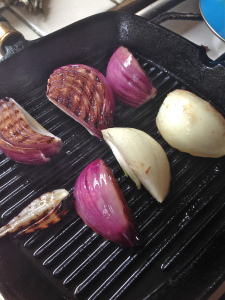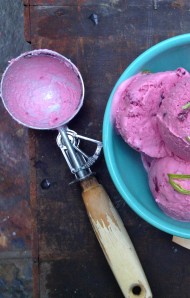Pomegranate molasses (also called grenadine molasses) is a staple in the countries of the Middle East and the Eastern Mediterranean. I recently discovered this syrup whilst trying to replicate this roasted red onion side dish which often accompanies meals in Turkish Restaurants here in London. I was surprised at how sour and tangy the molasses was given the sweet dry taste of a pomegranate. I would only recommend buying a small bottle at first (which can be purchased from most Middle Eastern shops).
Once you get use to its flavour, I think it will become a stable in your pantry. You can use it as a substitute to honey for glazing meat, poultry or roasted root vegetables like carrots. But traditionally it’s used as a dressing in salads or relishes. To achieve the sweet and sour taste here, I added fresh pomegranate juice to take the edge off the molasses.
Grilled Red Onions w/ Pomegranate Molasses
Ingredients:
2 red Onions 1 white Onion cut into quarters.
Sunflower Oil Spray (for the grill)
2 Garlic Cloves
2 tbsp Pomegranate seeds
1/2 cup Pomegranate juice
2 tbsp Pomegranate Molasses
Pinch of salt/ pepper
Method:
1. Put the grill pan on a high heat for about 3 minutes, then spray with oil.
Place the onion quarts on the grill for about 3 minutes per side or until it is well caramelized.
2. Once both sides of the onion have been grilled, break up the segments to allow the onion to soften a little more.
3. Remove from the grill and leave the garlic on the grill to roast some more. Once soft remove from grill and mash with a fork.
4. In a separate bowl, mix the pomegranate juice, molasses and garlic.
When you are ready to serve, strain the juice through a sieve to remove the garlic and pour over the onions.
Add the pomegranate seeds as a garnish.
5. Serve as a condiment or with warm flat bread.




